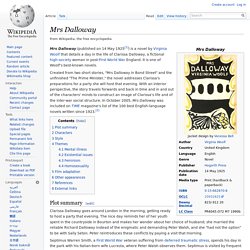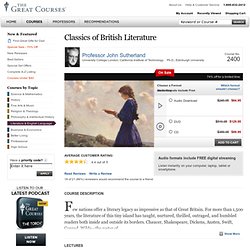

Mrs Dalloway. Plot summary[edit] Clarissa Dalloway goes around London in the morning, getting ready to host a party that evening.

The nice day reminds her of her youth spent in the countryside in Bourton and makes her wonder about her choice of husband; she married the reliable Richard Dalloway instead of the enigmatic and demanding Peter Walsh, and she "had not the option" to be with Sally Seton. Peter reintroduces these conflicts by paying a visit that morning. Septimus Warren Smith, a First World War veteran suffering from deferred traumatic stress, spends his day in the park with his Italian-born wife Lucrezia, where Peter Walsh observes them. Septimus is visited by frequent and indecipherable hallucinations, mostly concerning his dear friend Evans who died in the war.
Clarissa's party in the evening is a slow success. Characters[edit] Style[edit] Woolf laid out some of her literary goals with the characters of Mrs Dalloway while still working on the novel. Themes[edit] Mental illness[edit] Definition and Examples of Stream of Consciousness. Definition: Stream of Consciousness is a literary technique which was pioneered by Dorthy Richardson, Virginia Woolf, and James Joyce.

Stream of consciousness is characterized by a flow of thoughts and images, which may not always appear to have a coherent structure or cohesion. The plot line may weave in and out of time and place, carrying the reader through the life span of a character or further along a timeline to incorporate the lives (and thoughts) of characters from other time periods. Writers who create stream-of-consciousness works of literature focus on the emotional and psychological processes that are taking place in the minds of one or more characters. Important character traits are revealed through an exploration of what is going on in the mind. Also Known As: Interior Monologue. The Condition of England novel. Writers such as Charles Dickens, Elizabeth Gaskell and Charlotte Brontë illuminated contemporary social problems through detailed descriptions of poverty and inequality.

Dr Sophie Ratcliffe considers how the Condition of England novel portrayed 19th-century society, and the extent of its calls for reform. In the preface to her 1848 novel, Mary Barton, Elizabeth Gaskell reflected on the ‘unhappy state of things’ in Victorian England. Through the pages that followed she would, she said, highlight the divisions between ‘the employers and the employed’; she would speak for those who worked in the factories in appalling conditions, who struggled to feed their families, and who watched their children die from typhus. Condition-of-England Novels. He term the “Condition-of-England novels” refers to a body of narrative fiction, also known as industrial novels, social novels, or social problem novels, published in Victorian England during and after the period of the Hungry Forties.

The term directly relates to the famous “Condition of England Question” raised by Thomas Carlyle in “Chartism” (1839), although some of these narratives were published earlier. Condition-of-England novels sought to engage directly with the contemporary social and political issues with a focus on the representation of class, gender, and labour relations, as well as on social unrest and the growing antagonism between the rich and the poor in England. Mouvements littéraires. Méthode du commentaire composé. Quel est le but du commentaire ?

Il s’agit d’expliquer un texte et ses enjeux de manière ordonnée et structurée. Pour ce faire, deux démarches sont nécessaires : démarche analytique (1re étape) : expliquer le texte ;démarche synthétique (2e étape) : définir les grands axes de la réflexion. Dans un commentaire composé, il est fondamental d’organiser les analyses. Figure de style.
Les registres littéraires. La focalisation (ou point de vue) Cette page présente, de manière synthétique, les différents « points de vue » (focalisation) que peut adopter le narrateur.

La focalisation zéro Exemple :« Vers le milieu du mois d’octobre 1829, monsieur Simon Babylas Latournelle, un notaire, montait du Havre à Ingouville, bras dessus bras dessous avec son fils, et accompagné de sa femme, près de laquelle allait, comme un page, le premier clerc de l’Étude, un petit bossu nommé Jean Butscha. Fiche connaissance : le genre épistolaire. The Complete Guide to Interior Monologue. Interior monologue is the fancy literary term for a character's thoughts in a novel.

In real life, the stream of thoughts we all have running through our heads at any given moment is more often referred to as internal monologue, though the two terms mean precisely the same thing. Mouvements littéraires. Portrait. Magister. Si la notion de type de texte est assez claire (le texte se définit en fonction de son intention et de son type d'organisation ; voyez notre tableau), la notion de genre littéraire est plus floue : chaque époque définit sa notion de genre selon les attentes des lecteurs et les idéologies dominantes.

Néanmoins, dans chaque grand genre (roman, poésie, théâtre, argumentation), certains textes obéissent à un système d'énonciation comparable, sont traversés d'un même registre (l'impression particulière ressentie par le lecteur) ou traitent des thèmes convergents. On se tiendra à cette définition sommaire pour recenser les genres littéraires les plus fréquents, sans oublier que le propre de l'écrivain est de faire voler en éclat les prétendues barrières entre les genres. Approche du genre : les trois radicaux grecs qui constituent le mot définissent l'autobiographie comme "l'écriture de sa propre vie". Autobiographie. DÉFINITION. Langue française.
Figures de style. La notion de genres. Narratif. 813 Fiction. Classics of British Literature. British writers who have made a lasting impact on literature is remarkable.

More importantly, Britain's writers have long challenged readers with new ways of understanding an ever-changing world. The 48 fascinating lectures in Classics of British Literature provide you with a rare opportunity to step beyond the surface of Britain's grand literary masterpieces and experience the times and conditions they came from and the diverse issues with which their writers grappled. British-born Professor John Sutherland, the Lord Northcliffe Professor Emeritus of Modern English at University College London and Visiting Professor of Literature at the California Institute of Technology, has spent a lifetime exploring these rich works. The unique insights he shares into how and why these works succeed as both literature and documents of Britain's social and political history can forever alter the way you experience a novel, poem, or play. Explore the Soul of Great Britain. Livres Littérature d'expression anglaise.
Littérature américaine. Littérature Irlandaise. Littérature britannique. Littérature d'expression anglaise.